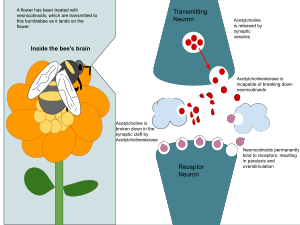Neonicotinoids: Difference between revisions
No edit summary |
No edit summary |
||
| (2 intermediate revisions by one other user not shown) | |||
| Line 1: | Line 1: | ||
[[File:The impact of neonicotinoids on synaptic transmission in insects.svg|alt=The impact of neonicotinoids on synaptic transmission in insects|thumb|The impact of neonicotinoids on synaptic transmission in insects]] | |||
'''Neonicotinoids''' are a class of neuro-active insecticides that are chemically similar to nicotine. They were developed by scientists at Shell and Bayer in the 1980s and are widely used in agriculture and urban landscapes. Neonicotinoids are absorbed by plants and can be present in pollen and nectar, making them a concern for their potential impact on bees and other pollinators. | '''Neonicotinoids''' are a class of neuro-active insecticides that are chemically similar to nicotine. They were developed by scientists at Shell and Bayer in the 1980s and are widely used in agriculture and urban landscapes. Neonicotinoids are absorbed by plants and can be present in pollen and nectar, making them a concern for their potential impact on bees and other pollinators. | ||
| Line 9: | Line 8: | ||
Across Europe and North America, a possible link to honey bee die-offs has made neonicotinoids controversial. In December 2013, the European Union significantly limited the use of clothianidin, imiadcloprid, and thiamethoxam on bee-attractive crops. In the United States, Canada, and elsewhere, local, state, and federal decision makers are also taking steps to protect pollinators from neonicotinoids.<ref name=":0" /> | Across Europe and North America, a possible link to honey bee die-offs has made neonicotinoids controversial. In December 2013, the European Union significantly limited the use of clothianidin, imiadcloprid, and thiamethoxam on bee-attractive crops. In the United States, Canada, and elsewhere, local, state, and federal decision makers are also taking steps to protect pollinators from neonicotinoids.<ref name=":0" /> | ||
== See also == | |||
* [[Bee]] | |||
== External links == | == External links == | ||
| Line 16: | Line 19: | ||
== References == | == References == | ||
<references /> | <references /> | ||
[[Category:Bees]] | |||
[[Category:Insects]] | |||
Latest revision as of 18:12, 17 August 2023

Neonicotinoids are a class of neuro-active insecticides that are chemically similar to nicotine. They were developed by scientists at Shell and Bayer in the 1980s and are widely used in agriculture and urban landscapes. Neonicotinoids are absorbed by plants and can be present in pollen and nectar, making them a concern for their potential impact on bees and other pollinators.
They are the most widely used group of insecticides in the world, and have been for a decade. They affect the nervous system of insects, humans, and other animals. They are highly toxic in small quantities to many invertebrates, including beneficial insects such as bees.[1]
Neonicotinoids can be present in pollen and nectar, making them toxic to pollinators that feed on them. The potentially long-lasting presence of neonicotinoids in plants makes it possible for these chemicals to harm pollinators even when the initial application is made weeks before the bloom period.[1]
Across Europe and North America, a possible link to honey bee die-offs has made neonicotinoids controversial. In December 2013, the European Union significantly limited the use of clothianidin, imiadcloprid, and thiamethoxam on bee-attractive crops. In the United States, Canada, and elsewhere, local, state, and federal decision makers are also taking steps to protect pollinators from neonicotinoids.[1]
